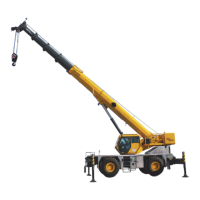2-85
TMS800E SERVICE MANUAL HYDRAULIC SYSTEM
Published 01-29-2014, Control # 496-00
CAB TILT CYLINDER
Description
The cab tilt cylinder (see Figure 2-59) is mounted beneath
the superstructure cab. The cylinder has a 3.81 cm (1.50 in)
diameter bore. The retracted length of the cylinder from
bushing center to bushing center is 57.4 cm (22.62 in). The
extended length of each cylinder from bushing center to
bushing center is 84.6 cm (33.31 in). Its stroke is 27.1 cm
(10.69 in). A wiper ring prevents foreign material from
entering each cylinder. O-rings and other seals prevent
internal and external leakage.
The cylinder weighs approximately 9.53 kg (25.5 lb) dry.
Maintenance
Disassembly
NOTE: Any maintenance requiring disassembly of the
cylinder should include replacement of all cylinder
seals.
1. Secure the cylinder in a clean work area by use of
clamps or a chain vise to prevent rolling.
2. Retract the cylinder fully to avoid damaging the rod
during removal.
NOTE: Mark or note the piston and head relationship to the
rod and barrel.
3. Clean away all dirt from the head. Place protective
padding around the rod near the head to prevent
damaging the chrome during head removal.
4. Position the rod mount with the ports facing down.
5. Using a means of collecting the oil, remove the port
plugs and allow cylinder to drain.
6. With the cylinder secured, pull the rod to full extension to
remove additional oil. Keep the rod supported and tap
the rod back 25 mm (1 in) after all oil is drained.
7. Remove the head as follows:
a. Place protective padding around the rod near the
head to prevent damaging the chrome during head
removal.
b. Insert a spanner wrench into the 1/4 in holes
provided.
c. Turn the head until the beveled end of the retaining
ring is visible in the mill slot.
d. If the head is difficult to turn or moves erratically, tap
the barrel adjacent to the head with a brass or
plastic mallet while turning it.
e. Pry the end of the retaining ring up with a thin blade
screwdriver or chisel and rotate the ring out through
the slot.
f. Tap the head out with a rubber mallet and allow any
excess fluid to drain into catch pan.
8. With the rod still supported, gently pull the piston and rod
from the barrel assembly being careful not to cock the
piston in the barrel.
9. Place the rod assembly on a surface that will not
damage the chrome or allow the rod assembly to drop.
10. Remove the piston as follows:
a. Secure the rod assembly by clamping on the rod
mount. Do not clamp on the chrome surface.
b. Remove the locknut and slide the piston off over the
threads. Use a rubber mallet only if the piston will
not pull or turn off.
c. Remove the head from same end as the piston
being careful not to pull across the threads.
11. Remove the seal and wear ring from the outside of the
piston.
12. Remove the O-ring from the rod.
NOTE: Arranging discarded seals and rings in the order of
disassembly will aid in installation of new seals and
rings. Pay attention to how each seal and ring is
installed to avoid installing replacement seals and
rings improperly.
13. Remove the O-ring, backup ring and retaining ring from
the outside of the head. Remove the seal and wiper ring
from the inside of the head.
CAUTION
Do not use air pressure to remove the rod. Use only a
source of controlled hydraulic oil pressure if the rod is
hard to remove.
CAUTION
Exercise extreme care when handling or setting down the
rod. Do not damage the chrome surface.
CAUTION
When removing seals and rings, avoid scratching the
grooved and gland surfaces.
Reference Only
